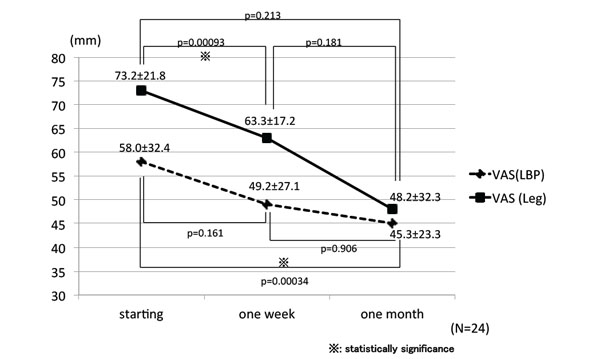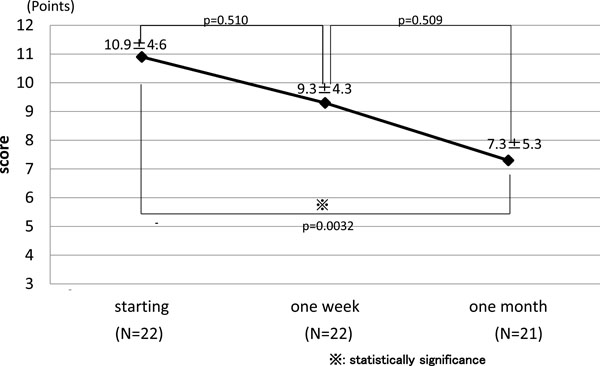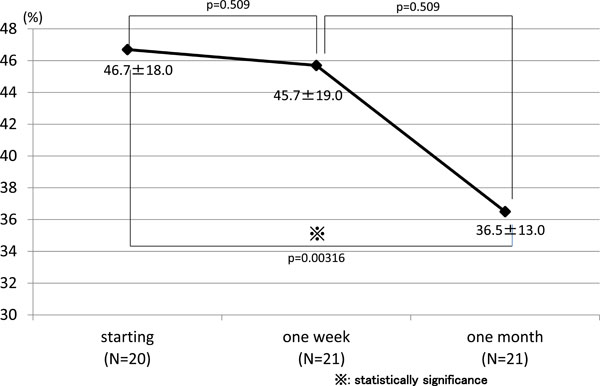All published articles of this journal are available on ScienceDirect.
Significant Efficacy of Tramadol/Acetaminophen in Elderly Patients with Chronic Low Back Pain Uncontrolled by NSAIDs: An Observational Study
Abstract
Chronic low back pain (LBP) is a common condition and is generally treated using non-steroidal anti-inflammatory drug (NSAID); however, chronic NSAID use can decrease renal function. Tramadol, a weak opioid agonist, may improve chronic LBP and disability, while avoiding adverse effects such as gastrointestinal and renal toxicity. However, few studies have evaluated the short-term efficacy of opioids in Asian patients with chronic LBP. In this study, 24 patients with chronic LBP unresponsive to NSAIDs (10 men, 14 women; mean age, 65.1 ± 12.1 years) were prescribed tramadol/acetaminophen (37.5 mg/325 mg; four tablets daily) for 1 month. Then, the following parameters were assessed at baseline and after 1 week and 1 month of treatment: leg pain and LBP (Visual Analog Score [VAS]); activity of daily life (Roland-Morris Disability Questionnaire [RDQ]); and disability (Oswestry Disability Index [ODI]). Leg pain resolved within 1 week (p = 0.00093); however, LBP was relieved only at 1 month (p = 0.00034). The mean RDQ (p = 0.015) and ODI (p = 0.0032) scores were improved at 1 month. A total 41.6% of patients reported nausea and floating sensation beginning tramadol/acetaminophen treatment, and 12.5% (four patients) discontinued treatment as a result. LBP did not improve in 25% of patients administered tramadol/acetaminophen. Because this was an observational study, rather than a comparative study, further investigation is needed to evaluate the long-term efficacy of tramadol/acetaminophen in elderly patients with chronic LBP unresponsive to NSAIDs.
INTRODUCTION
Low back pain (LBP) is a common and costly musculoskeletal condition in modern societies [1]. Chronic musculoskeletal pain affects the activity of daily life (ADL) in patients and contributes to mental health conditions [2].
The mean life expectancy in Japan currently exceeds 80 years in both men and women according to a 2014 report published by the Japanese Ministry of Health, Labor, and Welfare. However, there remains a 10-year gap between the mean life expectancy and the mean healthy life expectancy. The management of chronic musculoskeletal pain is critical in ensuring that elderly patients are as comfortable as possible [3]. Managing chronic pain not only benefits patients, but also their families. Currently in Japan, many children live far from their parents, and the elderly population within families is increasing. The family caregiver may also develop chronic pain; therefore, managing chronic pain can also help decrease the burden on caregivers.
Non-steroidal anti-inflammatory medications (NSAIDs) are frequently prescribed to elderly musculoskeletal patients in Japan; however, chronic NSAIDs use is not recommended in elderly patients because of the high incidence of complications such as renal failure, myocardial infarction, stroke, and gastrointestinal ulcers and hemorrhage, which can be fatal [4]. Chronic LBP often has a neuropathic component [5, 6]. Therefore, to prevent drug-induced complications and improve the patient ADL, I began prescribing tramadol, a weak opioid agonist, in combination with acetaminophen to patients with chronic LBP. In this report, I describe the observed effects of tramadol/acetamin-ophen treatment on the ADL, occurrence of disability, and the incidence of adverse events in patients with chronic LBP.
MATERIALS AND METHODS
All subjects (n = 24) were Japanese patients who complained of chronic LBP for more than 3 years with no resolution despite trying various NSAIDs. Patients were prescribed four tablets daily of tramadol/acetaminophen (TRAMCET® Combination Tablets; 37.5 mg tramadol/325 mg acetaminophen per tablet) from July to September of 2011. The patients were also prescribed metoclopramide (Primperan®; 11.52 mg/day) and magnesium oxide (Magmitt Tab®; 660-990 mg/day) to prevent nausea and constipation, symptoms secondary to opioid treatment.
To evaluate the therapeutic efficacy of the opioid on chronic pain, the LBP and leg pain were assessed using the Visual Analogue Scale (VAS), and adverse effects related to opioid therapy were recorded. The Roland Morris disability questionnaire (RDQ) was used to evaluate the change in daily activity due to LBP. This survey includes 24 items and is scored from 0 (no disability) to 24 (highest disability). The primary outcome measure for the study was the self-reported disability based on the RDQ administered 1 week and 1 month later. The Oswestry Disability Index (ODI) was also administered to assess any change in the reported disability [7]. The validated ODI evaluates the magnitude of LBP-specific disability at that moment and is scored from 0 (none) to 100 (complete disability) [8].
For statistical analysis, the Wilcoxon Signed rank test with Bonferroni correction was performed using ystat 2013 software (Igaku tosho, Japan). A two-tailed p value < 0.05 indicated statistical significance.
RESULTS
All the subjects had chronic LBP and/or leg pain that was not controlled with NSAIDs. The patient population included 10 men and 14 women with a mean (standard deviation) age of 65.1 ± 12.1 years. The diagnosed conditions of the patients are listed in Table 1. Fourteen of 23 cases were failed back surgery syndrome, and 10 cases were non-surgical. Among the non-surgical cases, surgery was recommended in four patients due to lumbar canal stenosis and L5 isthmic spondylolisthesis, but the patients elected to try medical management first. Three patients with lumbar disc herniation were prescribed tramadol/acetaminophen until surgery. One patient experienced significant pain reduction without motor deficits and chose to cancel surgery. The remaining two patients underwent microendoscopic discectomy.
Diagnosed pain conditions in the patient population.
| Disease | N |
|---|---|
| Failed back surgery syndrome | 14 |
| Lumbar spinal canal stenosis | 3 |
| Lumbar disc herniation | 3 |
| L5 isthmic spondylolisthesis | 1 |
| Spondylosis | 2 |
All patients were diagnosed with chronic LBP and did not improve with NSAID treatment. LBP, low back pain; NSAID, non-steroidal anti-inflammatory medication.
Tramadol/acetaminophen-related adverse events.
| Symptoms | N (%) |
|---|---|
| Nausea/ vomit | 13 (54.2%) |
| Constipation | 11 (45.8%) |
| Floating sensation and vertigo | 7 (29.2%) |
| dysgeusia | 3 (12.5%) |
| Restlessness | 1 (4.2%) |
Over half of patients experienced gastrointestinal symptoms such as nausea, vomiting, and constipation.
Opioids reduce the intensity of pain signals reaching the brain and modulate brain areas that control emotion, which further diminishes the intensity of a painful stimulus. However, opioids can also produce drowsiness, mental confusion, nausea, and constipation in a dose-dependent fashion. Therefore, adverse effects related to the tramadol/acetaminophen therapy were recorded and are summarized in Table 2. Thirteen patients (54.2%) reported nausea or vomiting despite being prescribed metoclopr-amide. Three of these 13 patients found the nausea and vomiting intolerable and discontinued tramadol/acetamino-phen treatment. Constipation was the second most frequent adverse effect (11 patients; 45.8%), despite all patients being prescribed a laxative agent. Seven patients (29.2%) reported experiencing a floating sensation and vertigo. One patient reported restlessness, and three patients reported dysgeusia.
To evaluate magnitude of pain relief provided by tramadol/acetaminophen, we measured the VAS for LBP and leg pain (Fig. 1). At 1 week after beginning tramadol/acetaminophen treatment, the VAS for leg pain was significantly reduced (p = 0.00093). LBP was not improved at 1 week, but showed significant improvement at 1 month after initiating treatment (p = 0.00034). As shown in Fig. (2), the mean RDQ before beginning tramadol/acetaminophen treatment was 10.9, and 1 month later, the RDQ significantly improved to 7.3 (1 week, p = 0.511; 1 month, p = 0.00034). The mean ODI initially was 46.7. At 1 week, there was no significant improvement in the ODI score (p = 0.509). One month after beginning treatment, the mean ODI improved to 36.5 (p = 0.00316; Fig. 3).

Mean (± SD) Visual Analog Score (VAS) for low back pain and leg pain after administering tramadol/acetaminophen. Leg pain significantly improved after 1 week of treatment (p = 0.00093); however, LBP only improved after 1 month of treatment (p = 0.00034). SD, standard deviation; LBP, low back pain.

Mean (± SD) Roland-Morris disability (RDQ) questionnaire scores after administering tramadol/acetaminophen. The RDQ score improved significantly at the 1-month follow-up visit (p = 0.0032). SD, standard deviation.

Mean (± SD) Oswestry Disability Index (ODI) score after administering tramadol/acetaminophen. The mean ODI score improved significantly at the 1-month follow-up visit (p = 0.00316).
DISCUSSION
Nakamura reported that the prevalence of chronic musculoskeletal pain was 15.4% in Japan [2]. LBP is the most frequently reported type of chronic musculoskeletal pain, affecting 65% of subjects with pain [2]. Managing chronic musculoskeletal pain is difficult for both patients and physicians due to its complicated pathology and unclear treatment. Multiple comorbidities are common in the general population (58%) and in people with back pain [9]. Musculoskeletal chronic in particular require a long treatment duration, which may still be unsuccessful.
In Japan, many orthopedic surgeons prefer to prescribe NSAIDs rather than acetaminophen for chronic musculoskeletal pain. NSAIDs are one of the most widely prescribed classes of drugs for pain and inflammation, particularly for musculoskeletal pain. However, older adults receiving NSAIDs should be routinely monitored for gastrointestinal, renal, and cardiovascular adverse effects, and for drug-drug and drug-disease interactions [10]. Gastrointestinal toxicity, which includes hemorrhage and ulceration, increases in frequency and severity with increasing age [11]. Co-administration of NSAIDs, corticosteroids, anti-thrombotic drugs, and low-dose aspirin in elderly patients increases the risk of NSAID-induced ulceration [12]. Especially in elderly patients, clinicians should consider the presence of comorbid disease to avoid these drug-drug and drug-disease interactions. NSAIDs are also nephrotoxic and exert both acute and chronic effects on kidney function. Chronic kidney disease (CKD) is a public health concern worldwide, particularly in elderly populations [13-15]. End stage kidney disease (ESKD) worsens the patient’s quality of life due to the need for renal transplant or kidney dialysis, generates burdensome medical costs globally. To avoid CKD progression, oral NSAIDs are not recommended for long-term use in at-risk patients [16]. NSAID use decreased after estimated glomerular filtration rate (eGFR) measurement was implemented [17]. Renal vasoconstriction and increased tubular sodium reabsorption may cause fluid retention and edema, and worsen congestive cardiac failure in CKD patients; NSAIDs may further aggravate chronic renal failure, particularly in patients prescribed diuretics or angiotensin converting enzyme inhibitors [18].
Tramadol/acetaminophen is superior to chronic NSAIDs due to its lower incidence of drug-induced gastrointestinal and renal toxicity. Tramadol is a centrally acting analgesic with two mechanisms of action: weak opioid agonist activity and inhibition of monoamine uptake. Tramadol appears to exert less gastrointestinal toxicity than NSAIDs [11]; however, confusion may be a problem in elderly patients. In the present population, none of the patients experienced confusion, but many other adverse events occurred, as summarized in Table 2. This observational study was only conducted for 1 month; additional examination is needed to survey the long-term adverse effects.
A cohort study found that cumulative opioid use of at least 180 days over a 3.5-year period was associated with an increased risk for myocardial infarction [19]. Another cross-sectional study of men with back pain found that, compared with non-use, long-term opioid use was associated with an increased use of medications for erectile dysfunction or testosterone replacement [20]. There are no known primary studies examining tramadol use in elderly patients [10]. Careful monitoring for toxicity and efficacy is critical, given that advanced age increases the risk for adverse effects [16]. Elderly patients in particular may suffer from extrapyramidal symptoms [21]. Nausea and vomiting, which affected 54.2% of the present population (Table 2), are well-known adverse effects of tramadol. To reduce these adverse effects, we prescribed antiemetic medications. Certain antiemetic medications may worsen extrapyramidal symptoms; therefore, careful monitoring is required when administering these medications.
Opioid withdrawal syndrome is considered a lesser concern by orthopedic surgeons in Japan. Three patients discontinued tramadol/acetaminophen because of intolerable nausea. These patients were prescribed four tablets of tramadol/acetaminophen daily, and the sudden discontinuat-ion for nausea placed them at very high risk of withdrawal syndrome [22]. To avoid sudden discontinuation of tramadol due to its adverse effects, I recently began employing the titration method [23], which reduced the incidence of nausea to 11.8% in my patients (data not shown).
In the present patient population, leg pain was reportedly more severe than LBP (Fig. 1). Tramadol/acetaminophen relieved leg pain within 1 week, while LBP was unchanged until several weeks later. In this study, radiculopathy could be attributed to spinal lesions such as a herniated disc. By contrast, nonspecific LBP is difficult to diagnose and treat even using tramadol/acetaminophen. When tramadol/aceta-minophen was continually administered for 1 month, LBP was alleviated (Fig. 1), indicating that LBP may be a more complex condition than radicular pain.
A previous study suggested that the increase in the mean RDQ score associated with opioid administration was small and therefore unlikely to be clinically important [24]. In this study, all patients received the same opioid dose, and the RDQ score did not improve during the first week. Despite the immediate improvement in leg pain within 1 week (Fig. 1), additional time was required to improve the level of disability (Fig. 2). Both the RDQ and ODI are self-reported disability questionnaires, but they yielded different results, as shown in Figs. (2, 3). The RDQ score improved in a time-dependent manner (Fig. 2). There was no significant change in the mean RDQ score between baseline and the 1-week follow-up (Fig. 3). Between the 1-week and 1-month follow-ups, the mean RDQ score improved, but the change was not statistically significant (p = 0.509).
The ODI includes questions on sleeping habits and social function, which are not included in the RDQ. In this study, sleeping habits were not examined in the patient group; evaluating the relationship between sleep patterns and severe pain may be important. Recently, Yarias [25] reported that transdermal buprenorphine improved sleep quality and reduced sleep disturbances in patients with moderate-to-severe chronic LBP. They reported a correlation between the change in sleep patterns and pain severity, and found that the magnitude of pain reduction mediated the therapeutic effect on sleep outcomes [25]. The benefits of transdermal buprenorphine on sleep outcomes emerged within 4 weeks in the previous study, which may be reflected in the improved ODI score after 1 month of opioid treatment in the present study.
Four tablets of tramadol/acetaminophen results in 1300 mg of acetaminophen administered per day. Acetaminophen is the most common cause of drug-induced acute liver failure [26]; therefore, the acetaminophen dose should be considered. Acute overdose or inappropriate therapy may cause hepatotoxicity, and additional factors, such as concomitant alcohol use or abuse, concurrent medications, genetic predisposition, and nutritional status, can influence the susceptibility to and severity of acetaminophen (APAP) hepatotoxicity. Early manifestations of APAP hepatotoxicity are nonspecific, but require prompt recognition by physicians [27]. Several studies report that musculoskeletal chronic pain was not associated with alcohol consumption [28-31], but other studies have shown that alcohol abuse was significantly more frequent among patients with LBP [32], and poor health is associated with episodic heavy alcohol use [33]. Therefore, acetaminophen hepatotoxicity risk factors should be considered in LBP patients. In patients who consume alcohol, it is best to avoid acetaminophen-containing opioids; otherwise, hepatic injury may occur.
Tramadol is a frequently prescribed opioid analgesic in the United Kingdom and is becoming increasingly popular among drug users [34]. Tramadol is a commonly misused opioid and is associated with drug abuse [35, 36]. As of 2014, only quick-release formulations of tramadol/acetam-inophen are available in Japan. Quick-release opioids have a higher risk of drug abuse than slow-release formulations. Therefore, care is needed when prescribing tramadol to patients. In CKD patients, clinicians should also carefully consider the tramadol dose [37]. Weak opioids such as tramadol/acetaminophen may improve chronic LBP and disability, but clinicians must take steps to avoid its misuse and abuse, as well as opioid-related adverse effects.
LIST OF ABBREVIATIONS
CONFLICT OF INTEREST
The author confirms that this article content has no conflict of interest.
ACKNOWLEDGEMENTS
Declared none.


